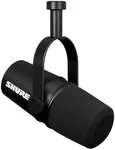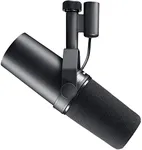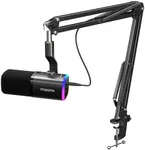Buying Guide for the Best Microphones For Live Vocals
Choosing the right microphone for live vocals is crucial for delivering a clear and powerful performance. The right microphone can enhance your voice, reduce unwanted noise, and ensure that your audience hears you as intended. When selecting a microphone, consider the environment in which you'll be performing, the style of your music, and your vocal characteristics. Understanding the key specifications will help you make an informed decision that suits your needs.Polar PatternThe polar pattern of a microphone describes how it picks up sound from different directions. This is important because it affects how much ambient noise is captured along with your voice. Common polar patterns include cardioid, supercardioid, and omnidirectional. Cardioid microphones pick up sound primarily from the front, making them ideal for live vocals as they minimize background noise. Supercardioid microphones have a tighter pickup pattern, offering even more isolation from surrounding sounds, which is useful in loud environments. Omnidirectional microphones capture sound equally from all directions, which can be useful in quieter settings but may pick up more ambient noise. Choose a polar pattern based on the level of noise in your performance environment and how much isolation you need.
Frequency ResponseFrequency response refers to the range of frequencies a microphone can pick up, from the lowest bass to the highest treble. This is important because it affects how your voice will sound through the microphone. A flat frequency response means the microphone captures all frequencies equally, which is great for a natural sound. Some microphones have tailored frequency responses that emphasize certain frequencies, such as the midrange, to enhance vocal clarity. If you have a deep voice, you might prefer a microphone that captures lower frequencies well, while a microphone that emphasizes higher frequencies might suit a higher-pitched voice. Consider your vocal style and the sound you want to achieve when evaluating frequency response.
SensitivitySensitivity indicates how well a microphone converts sound into an electrical signal. This is important because it affects how much gain you need to apply to get a good signal level. High-sensitivity microphones pick up quieter sounds more easily, which can be beneficial for soft singers or quieter performances. However, they may also pick up more background noise. Low-sensitivity microphones require more gain, which can be useful in loud environments to avoid feedback. Consider your vocal volume and the typical noise level of your performance environment when choosing the sensitivity of your microphone.
DurabilityDurability refers to how well a microphone can withstand the rigors of live performance, including handling, transportation, and environmental factors. This is important because live performances can be demanding, and a durable microphone will last longer and perform reliably. Dynamic microphones are generally more robust and can handle rough handling better than condenser microphones, which are more delicate. If you perform frequently or in challenging environments, prioritize a microphone known for its durability. Consider how often you perform and the conditions you typically encounter when assessing durability.
ConnectivityConnectivity refers to how the microphone connects to your sound system. This is important because it affects compatibility and ease of use. Most live vocal microphones use XLR connections, which provide a balanced signal and are standard in professional audio setups. Some microphones offer wireless connectivity, which can provide more freedom of movement on stage but may require additional equipment like a receiver. Consider your setup and whether you need the flexibility of wireless or the reliability of wired connections when choosing connectivity options.



















